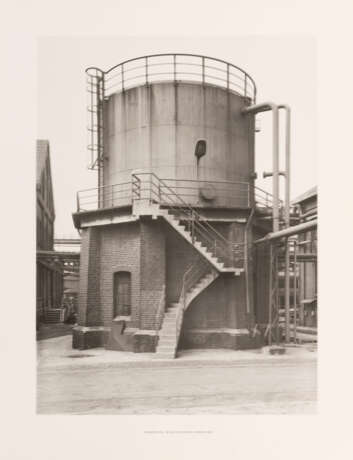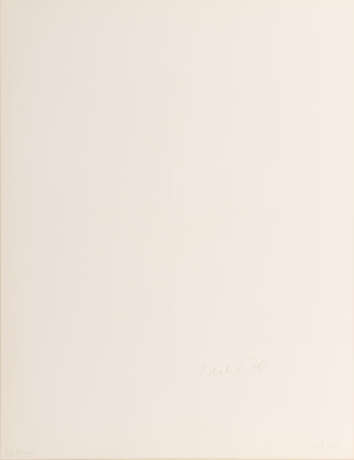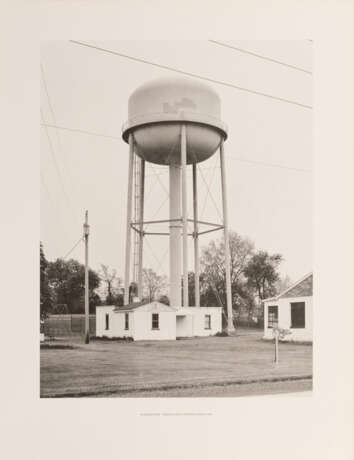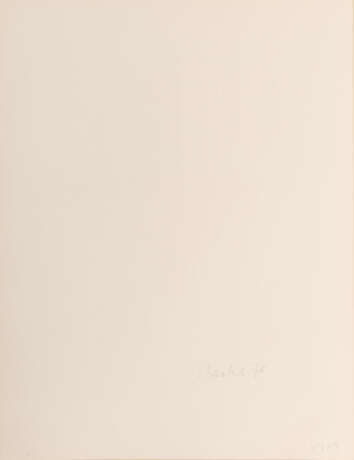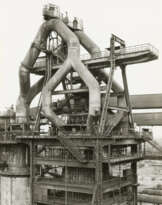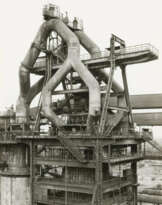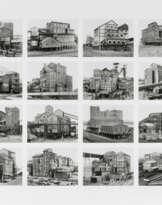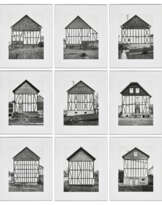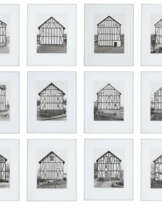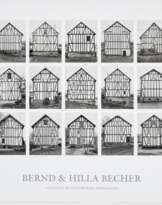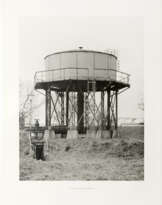Bernd und Hilla Becher (1931 Siegen - 2007 Rostock/1934 Potsdam - 2015 Düsseldorf) (F)
02.12.2023 13:00UTC +01:00
Classic
Sold
4400EUR € 4 400
| Auctioneer | WETTMANN | Auktionshaus an der Ruhr |
|---|---|
| Event location | Germany, Mülheim an der Ruhr |
| Buyer Premium | 30% |
Archive
The auction is completed. No bids can be placed anymore.

ID 1066865
Lot 68 | Bernd und Hilla Becher (1931 Siegen - 2007 Rostock/1934 Potsdam - 2015 Düsseldorf) (F)
Estimate value
€ 950 – 1 400
Bernd und Hilla Becher (1931 Siegen - 2007 Rostock/1934 Potsdam - 2015 Düsseldorf) (F)
Sechs Wassertürme, 6-tlg., je Offsetlithografie auf glattem Papier, je 52 cm x 40 cm Blattmaß, unterhalb der Darstellung typografisch bezeichnet, verso signiert, 76 datiert, partiell Griffspuren entlang der Blattkanten, leicht lichtrandig, Literatur: Griffelkunst-Vereinigung/Hamburg-Langenhorn (hrsg.)/Harald Rüggeberg: Griffelkunst - Verzeichnis der Editionen (1976-2000), Band I, Hamburg 2002, Nr. 204 A1-A6.
Bernd und Hilla Becher zählen zweifellos zu den bedeutendsten Künstlerpaaren des 20. Jahrhunderts, indem sie die Fotografie industrieller Architektur maßgeblich prägten. In den späten 1950er Jahren begann das Künstlerpaar mit dieser Arbeit, die später als "Typologies" (Typologien) bekannt wurde. Ihre Herangehensweise war akribisch und systematisch. Sie fotografierten industrielle Strukturen wie Wassertürme, Hochöfen, Gasbehälter und Fabriken in Schwarz-Weiß. Ihre Fotos sind geprägt von einer klaren, sachlichen Ästhetik und einer Betonung der Formen, Strukturen und Geometrie. Neutrale Hintergründe heben die visuellen Details und architektonischen Formen hervor. Die Bechers strebten danach, die Schönheit und Funktionalität dieser oft übersehenen industriellen Bauten zu dokumentieren. Indem sie die Objekte in seriellen Gruppen präsentierten, schufen sie eine visuelle Taxonomie der industriellen Architektur. Durch die Gleichförmigkeit ihrer Darstellung wurde die Aufmerksamkeit auf die subtilen Unterschiede zwischen den einzelnen Bauten gelenkt. Diese Ansicht von Gebäuden als architektonische "Typen" war wegweisend und legte den Grundstein für das Verständnis von Fotografie als dokumentarische Kunstform. Die Arbeit von Bernd und Hilla Becher hat nicht nur das Genre der dokumentarischen Fotografie geprägt, sondern auch die Wahrnehmung von Industrie und Architektur in der Kunst verändert. Sie schufen eine neue Perspektive auf die Art und Weise, wie wir die Strukturen um uns herum betrachten. Ihr Schaffen erinnert uns daran, dass Schönheit in den unerwartetsten Orten zu finden ist und dass sogar scheinbar banale Gebäude eine tiefe ästhetische Bedeutung haben können.
Bernd and Hilla Becher (1931 Siegen - 2007 Rostock/1934 Potsdam - 2015 Düsseldorf) (F)
Six water towers, 6-piece, each offset lithograph on smooth paper, each 52 cm x 40 cm sheet dimensions, typographically inscribed below the image, signed on verso, dated 76, partial traces of handling along the edges of the sheet, light margins, Literature: published by the Griffelkunst-Vereinigung/Hamburg-Langenhorn, Rüggeberg, Harald: Griffelkunst - Verzeichnis der Editionen (1976-2000), Volume I, Hamburg 2002, No. 204 A1-A6
Bernd and Hilla Becher are undoubtedly one of the most important artist couples of the 20th century in that they had a decisive influence on the photography of industrial architecture.In the late 1950s, the artist couple began this work, which later became known as ''Typologies''. Their approach was meticulous and systematic. They photographed industrial structures such as water towers, blast furnaces, gas tanks and factories in black and white. Their photographs are characterised by a clear, matter-of-fact aesthetic and an emphasis on shapes, structures and geometry. Neutral backgrounds highlight the visual details and architectural forms.The Bechers strove to document the beauty and functionality of these often overlooked industrial buildings. By presenting the objects in serial groups, they created a visual taxonomy of industrial architecture. The uniformity of their presentation drew attention to the subtle differences between individual buildings. This view of buildings as architectural ''types'' was groundbreaking and laid the foundation for the understanding of photography as a documentary art form. The work of Bernd and Hilla Becher not only shaped the genre of documentary photography, but also changed the perception of industry and architecture in art. They created a new perspective on the way we look at the structures around us. Their work reminds us that beauty can be found in the most unexpected places and that even seemingly banal buildings can have deep aesthetic meaning.
| Artist: | Bernd and Hilla Becher |
|---|---|
| Auction house category: | Modern and Contemporary art |
| Artist: | Bernd and Hilla Becher |
|---|---|
| Auction house category: | Modern and Contemporary art |
| Address of auction |
WETTMANN | Auktionshaus an der Ruhr Friedrichstraße 67-67a 45468 Mülheim an der Ruhr Germany | ||||||||||||||
|---|---|---|---|---|---|---|---|---|---|---|---|---|---|---|---|
| Preview |
| ||||||||||||||
| Phone | +49 (0)208 3059081 | ||||||||||||||
| Fax | +49 (0)208 4391735 | ||||||||||||||
| Buyer Premium | 30% | ||||||||||||||
| Conditions of purchase | Conditions of purchase | ||||||||||||||
| Business hours | Business hours
|


